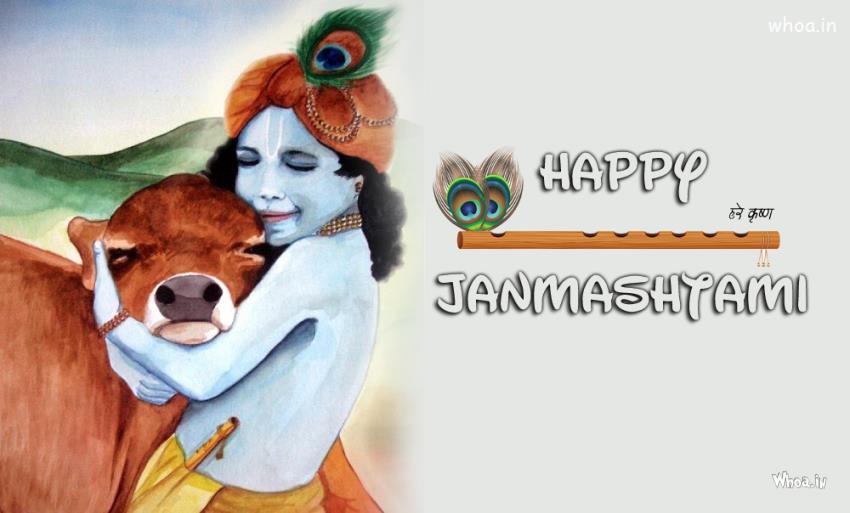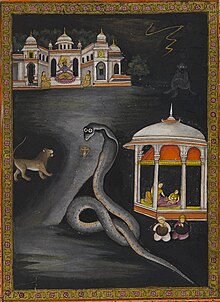
Krishna Janmashtami
From Wikipedia, the free encyclopedia
| Krishna Janmashtami | |
|---|---|

Baby Krishna
| |
| Also called | Janmashtami / Dahi Handi |
| Observed by | Hindus |
| Type | Religious |
| Observances | Fasting, praying |
| Date | Bhadrapada, Ashtami |
| 2013 date | 28 August |
| Related to | Krishna |
Krishna Janmashtami (Devanagari कृष्ण जन्माष्टमी kṛṣṇa janmāṣṭamī), also known asKrishnashtami, Saatam Aatham, Gokulashtami, Ashtami Rohini, Srikrishna Jayanti,Sree Jayanti or sometimes merely as Janmashtami, is an annual commemoration of the birth of the Hindu deity Krishna, the eighth avatar of Vishnu.[1]
The festival is celebrated on the eighth day (Ashtami) of the Krishna Paksha (dark fortnight) of the month of Shraavana (August–September; However, in both traditions it is the same day. So, we have works like Vishnudharmottara Purana saying Krishna Ashtami is in the Bhadrapada month and Skanda Purana stating that it falls in the month of Shravana) in the Hindu calendar. Rasa lila, dramatic enactments of the life of Krishna, are a special feature in regions of Mathura and Vrindavan, and regions followingVaishnavism in Manipur.[2] While the Rasa lila re-creates the flirtatious aspects of Krishna's youthful days, the Dahi Handi celebrate God's playful and mischievous side, where teams of young men form human towers to reach a high-hanging pot of butter and break it. This tradition, also known as uriadi, is a major event in Tamil Nadu on Gokulashtami. Krishna Janmashtami is followed by the festival Nandotsav, which celebrates the occasion when Nanda Baba distributed gifts to the community in honour of the birth.[3]
Contents
[hide]Birth[edit]
Krishna was the 8th son of Devaki and Vasudeva. Based on scriptural details andastrological calculations, the date of Krishna's birth, known as Janmashtami,[4] is 19 July 3228 BCE and he lived until 3102 BCE. Krishna belonged to the Vrishni clan of Yadavasfrom Mathura,[5] and was the eighth son born to the princess Devaki and her husbandVasudeva.
Mathura (in present day Mathura district, Uttar Pradesh) was the capital of the Yadavas, to which Krishna's parents Vasudeva and Devaki belonged. King Kansa, Devaki's brother,[6]had ascended the throne by imprisoning his father, King Ugrasena. Afraid of a prophecy that predicted his death at the hands of Devaki's eighth son, Kansa had the couple locked in a prison cell. After Kansa killed the first six children, and Devaki's apparent miscarriage of the seventh (which was actually a secret transfer of the infant to Rohini as Balarama), Krishna was born.
Following the birth, Vishnu ordered Vasudeva to take Krishna to Gokul to Nanda andYashoda,[citation needed] where he could live safely, away from his Uncle Kansa. Vasudevatook Krishna with him and crossed Yamuna to reach Gokul. There, everyone was asleep; so he quietly kept him there and returned with Yashoda's daughter. Kansa, thinking her to be Devki's eight child, threw her on a stone. But she rose into the air and transformed into Yogmaya (who is Vishnu's helper) and warned Kansa about his death. Then, she disappeared. Krishna grew up in Gokul with his brother, Balram. He then returned to Mathuraand killed Kansa with the help of Balram.
Celebrations[edit]
Hindus celebrate Janmashtami by fasting and staying up until midnight, the time when Krishna is believed to have been born. Images of Krishna's infancy are placed in swings and cradles in temples and homes. At midnight, devotees gather around for devotional songs, dance and exchange gifts. Some temples also conduct readings of the Hindu religious scripture Bhagavad Gita.[7]
Maharashtra[edit]
See also: Govinda sport
Janmaashtami/ Gokulashtami ( Marathi- गोकुळाष्टमी ), popularly known in Mumbai andPune as Dahi Handi, is celebrated with enormous zeal and enthusiasm. The handi is a clay pot filled with buttermilk that is positioned at a convenient height prior to the event. The topmost person on the human pyramid tries to break thehandi by hitting it with a blunt object. When the handi breaks, the buttermilk is spilled over the entire group, symbolising their achievement through unity. Handis are set up around the city, and groups of youngsters –called GovindaPathaks – travel around in trucks trying to break as many handis as possible during the day.
Many – such as Govinda Pathaks – compete with each other, especially for the handis that dole out hefty rewards. The event, in recent times, has gathered a political flavour, and it is common for political parties and rich community groups to offer prizes amounting to lakhs of rupees.
Some of the most famous handis are at Dadar, Lower Parel, Worli, Mazgaon, Lalbaug, Thane and Babu Genu, Mandai in Pune.[8]
Cash and gifts are offered for Govinda troops to participate; for over 4,000 handis in Mumbai, 2,000 Govinda troops compete for the prizes.
Manipur[edit]
Janmaashtami – popularly known in Manipur as Krishna Janma – is a significant festival celebrated at two temples in Imphal, the capital city of Manipur. The first festival is at the Govindaji temple, and the second is at the International Society for Krishna Consciousnesstemple. Devotees of Lord Krishna gather mostly at the ISKCON temple.
Northern and Eastern India[edit]
Places in Uttar Pradesh that are associated with Krishna's childhood, such as Mathura,Gokul and Vrindavan, attract visitors from all over India, who go there to participate in the festival celebrations.[9] People in the city of Dwarka in Gujarat – where Krishna is believed to have established his Kingdom – celebrate the festival by visiting the Dwarkadhish temple. In Jammu, kite flying is an important part of the celebration on his day.[10]
In the eastern state of Odisha, in the region around Puri and in Nabadwip, West Bengali people celebrate Janmashtami by fasting and worship until midnight. Purana Pravachana from the Bhagavata Purana are recited from the 10th Skandha. This section deals with pastimes of Lord Krishna. The next day is called Nanda Utsav or the joyous celebration of Krishna's foster parents Nanda andYashoda. On this day, people break their fast and offer various cooked sweets during the early hours.
South India[edit]
In Southern India, floors in houses are decorated with footprints made from flour, to symbolise Krishna's childhood sport of stealing butter from houses.[11]
Nepal[edit]
Eighty percent of the population of Nepal identify themselves as Hindus and celebrate Krishna Janmashtimi. They observe Janmashtami by fasting until midnight. They chant Slokas from the Bhagavad Gita and sing religious songs called bhajans. The temples of Lord Krishna are decorated, and bhajans and kirtans are sung or played. The Krishna Mandir in Patan Durbar Square, Narayanhiti Krishnamandir, and other temples of Lord Krishna are the centres for festivities on Krishna Janmaasthimi. Numerous devotees flock to the ancient Krishna temple in old Patan Durbar Square to keep vigil through the revered night of his birth. Observances include people sitting closely together, bodies rocking as women chant the many names of Lord Krisha, such as Narayan, Narayan and Gopal, Gopal.Some sing hymns, others clap their hands, while some others pray. Crowds of men and women edge their way slowly up narrow steps through the seated devotees to the temple's dark interior, to where the main idol stands. There they offer flowers, coins and food, and wait for a glimpse of the Krishna Janmashtami idol. After the temple priest gives them prasad, they make their way home.[citation needed]
Bangladesh[edit]
| An article related to |
| Hinduism |
|---|
 |
Janmashthami is a national holiday in Bangladesh.[12] On Janmashthami, a procession starts fromDhakeshwari Temple in Dhaka, the National Temple of Bangladesh, and then proceeds through the streets of Old Dhaka. The procession dates back to 1902, but was stopped in 1948 following the establishment of Pakistan and subsequent attacks by Muslim mobs in Dhaka. The procession was resumed in 1989.[13]
Pakistan[edit]
Janmashthami is celebrated by Pakistani Hindus in the Shri Swaminarayan Mandir in Karachi with the singing of bhajans and delivering of sermons on Krishna.[14]
Outside South Asia[edit]
The first ever elected government official in the world to issue proclamation for the celebrationJanmashtami is Janet Napolitano, while she was the Governor of Arizona. The festival is also celebrated widely by Hindus in Caribbean in the countries of Guyana, Trinidad and Tobago, Jamaica and the former Dutch colony of Suriname. The Hindus in these countries origianted from Uttar Pradesh and are the descendants of indentured immigrants from UP.
Street plays[edit]
For the past few years, several thousand teams of youth perform street plays on the occasion of Janmashtami worldwide. The performers of these plays are inspired by Pandurang Shastri Athavale, of the Swadhyay Pariwar, to spread the message of Krishna. They disseminate the thoughts of Bhagavad Gita through street plays around the week of Janmashtami.




No comments:
Post a Comment